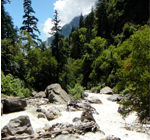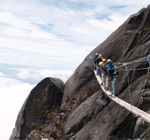
the valley of flowers
Up in the Himalayan mountain ranges in Uttarakhand province lies a magical land where fairies frolic and flowers have magical powers to protect the valley and all ...
More
text and images . Pauline Chan
You saw it 'destroyed' in Transformers II and you saw Indiana Jones approach it on his horse in The Last Crusade. The Al-Khazneh or the Treasury, is one of the most famous sights in the world. Some archaeologists have even ranked it as the eighth wonder of the ancient world. The Treasury is part of the ancient city of Petra, one of the greatest archaeological treasures of the world and undoubtedly, the most famous attraction in Jordan. The monuments are unbelievable feats of ancient engineering as they are carved into the face of the rock. The cliff formations and colour, naturally sculptured by the elements are art and poetry that no man can replicate.
Petra was the principal city of the ancient Nabataea. The Nabataeans were ancient Arab tribes who originally came from the Arabian Peninsula, more than 2,200 years ago, and settled in southern Jordan. Under Nabataean rule, Petra became the centre for spice trade that extended from Arabia to Aqaba and Petra, and onward either to Gaza in the northwest, or to the north through Amman to Bostra, Damascus and finally on to Palmyra and the Syrian desert. They were engaged in the caravan business and became the undisputed masters of the region's trade routes, levying tolls, protecting caravans laden with Arabian frankincense and myrrh, Indian spices and silks, African ivory and animal hides. 
The thriving caravan business enabled the Nabataeans to establish and organise a powerful kingdom that stretch to Damascus and included parts of the Sinai and Negrev deserts, effectively ruling the greater part of Arabia. Their kingdom was not ruled without interference from foreign threats. Wars were fiercely fought and tactical diplomacy was applied to preserve their independence and civilisation. In 106 A.D., the inevitable happened and the Nabatean Kingdom was annexed to the Roman Empire. Petra and Nabataea became a part of the Roman province known as Arabia Petraea with its capital at Petra. Despite Roman rule, Petra flourished and prospered for many years until factors such as a shift in trade routes and lack of demand for frankincense caused a fall in its riches. After reaching its historical peak, Petra was gradually abandoned and after the 14th century, it was completely lost to the West, until Johann Ludwig Burckhardt, a Swiss traveler, rediscovered it in 1812.
The Nabataeans were clever people. They were famous chiefly for 2 things: trade and their hydraulic engineering systems. The latter is their most remarkable of all Nabataean achievements that included water conservation systems and the dams that were constructed to divert the rush of swollen winter waters that create flash floods. They never believed in national exclusiveness and were open to outside cultural influences, absorbing them and adding them to their own native traditions so that the result was a wonderful cultural melting pot. The walk through to the entrance of Petra attests to this. Look at any carved monument and you will see classical Graeco-Roman, Egyptian, Mesopotamian and local styles all fused into one unified artwork. The city was full of Nabataean creativity and inventions - agricultural terraces, water harvesting systems, paved roads, artwork, temples and theatres.
Petra is a three-hour drive from the Jordanian capital, Amman, on the modern desert highway, or five hours on the more scenic Kings Highway. Petra is a huge archaeological site and to explore it is an unforgettable experience which will require about three days for a complete exploratory coverage. Here are some of the most important sites of this ancient city:
Obelisk Tomb and Bab As-Siq Triclinium
A beautiful monument that combines the styles of the East and West. The Obelisk is Egyptian influence while the niche between the obelisks is Greaco-Roman influence. The Triclinium is a chamber with three benches, the purpose of which was the Nabataean celebration of sacred feasts, which took place every year in honour of the dead.
As-Siq
The ancient main entrance to Petra. This tunnel-like path features an impressive 1,200 metres long, deep and narrow gorge of stunning natural beauty The Sid is hemmed in by cliffs soaring up to 80 metres. When you pass through this path, you get to see the typical Petraen features - bizarre-looking geological formations, colourful rocks, agricultural terraces, water channels cut into the cliffs, dams and votive-niches carved into the rock. One walks with anticipation of the famous facade of the Treasury which appears gradually and mysteriously at the end of the path.
Al-Khazneh (The Treasury)
A dazzling monument that completely takes your breath away when you catch sight of its rosy pink and peach facade as you reach the end of the Siq. The architectural style is quite unique in the ancient world. The main inspiration was Hellenistic, Alexandrian Hellenistic, plus Nabataean. Visitors are dwarfed by the gigantic facade (30 metres wide and 43 metres high) and its splendour can only be truly felt when you are physically there. It was carved int he first century BC as a tomb of an important Nabataean king; some scholars believed it was later used as a temple. The elaborately-carved facade represents the engineering genius of the Nabataeans. 
Streets of Facade and the Theatre
The Street has rows of Nabataen tombs with intricate carvings. The Theatre built in the first century looks Roman and is carved into solid rock except towards the front on either side.
Royal Tombs
Urn Tomb - The largest of the royal tombs, the immense courtyard and main chamber (17 x 18.9 metres in size) are imposing. Believed to have been carved around 70 A.D.
Palace Tomb - An exquisitely-carved monument with the appearance of a palace. It is badly eroded but it still appears majestic with its richly decorated columns and pillars.can hire a horse or a horse-drawn carriage to take you through the one kilometre Siq
Sextius Florentinus Tomb - The Latin inscription over the doorway made it clear who the tomb was built for. Sextius was a Roman governor of the province of Arabia who, according to the inscription, wished to be buried in Petra. It was carved around 126-130 A.D.
Colonnaded Street
A beautiful colonnaded street, which led through the city centre, flanked by temples, public buildings and shops. A nymphaeum (ancient Greek and Roman sanctuary consecrated to water nymphs) once adorned the street and the marble pavement is still visible today.
Qasr al-Bint
Probably the main temple of the Nabataean capital, it is the only freestanding building in Petra to have survived centuries of earthquake and floods. Its solid-looking design dominates a large paved holy precinct which was open to common worshippers while the temple itself and the altar in front of it were the realm of the priests.
Ad-Deir (The Monastry)
Petra's second most-famed attraction - the Al-Deir - is situated up a flight of 800 steps cut into the rocks at the top of the Ad-Deir mountain. It is huge and beautiful, resembling the Treasury, but the architectural embellishment is simplified. It was either a tomb, a temple or both.
In 1985, UNESCO designated Petra as a World Heritage Site. The Petra Archaeological Park (PAP) covers 264,000 square metres within Wadi Musa, The best time to see Petra, especially if you’re planning to take photographs, is either early to mid-morning or late afternoon, when the angled sun highlights and enhances the amazing natural colours of the rocks. Visitors have to walk through the one kilometre Siq to get to the Treasury but you can hire a horse, donkey, camel or horse-drawn carriage to take you there.

the valley of flowers
Up in the Himalayan mountain ranges in Uttarakhand province lies a magical land where fairies frolic and flowers have magical powers to protect the valley and all ...
More

a rock solid via ferrata adventure
If you are looking for mountain views and thrills the likes of a National Geographic documentary, Kota Kinabalu has Asia's first, newest and highest Via Ferrata ...
More

have you gone mad yet?
This summer’s blockbuster movie, Green Lantern, is covered in all the movie news, magazines and fan sites. There is green everywhere and our favourite coverage is ...
More